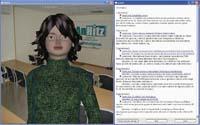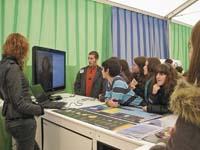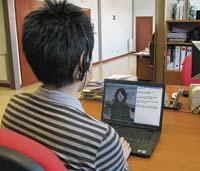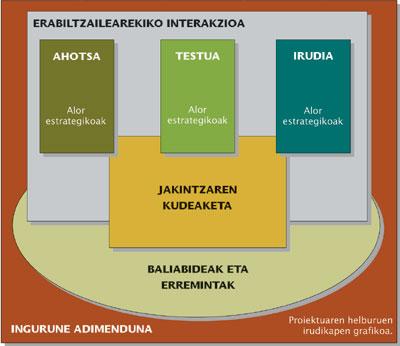AnHitz, virtual science expert
2009/01/01 Kortabitarte Egiguren, Irati - Elhuyar Zientzia Iturria: Elhuyar aldizkaria

The AnHitz project, developed between 2006 and 2008, is the result of the presentation in mid-November of the demo or AnHitz. AnHitz is a virtual character expert on scientific issues. He speaks Basque. He is able to understand the questions that arise and answer them. He is therefore an interactive virtual character, expert in science and euskaldun.
User questions about science and technology (Who invented the telescope?, When did they find penicillin? Where was Newton born?...) can do it in Basque to the system. The system also offers answers in Basque. In addition to answering questions, if a query is made in one or several words, it is able to search for the documents associated with that query.
Consultations through one or more words are also carried out in Basque (ozone layer, capacity to drink milk in evolution, advantages and disadvantages of renewable energy sources...), but also seeks documents in Spanish and English related to such consultations, in addition to in Basque. The system automatically translates into Basque those of Spanish, and for the moment those of English give them in the original language, but in short it will also translate them into Basque.
To carry out this task, look at different sites of science and technology on the Internet. In addition, if desired, the system reads these texts in any of the three languages. In addition, by clicking on the title of the texts, the user can access their original website and the translated automatically if desired. Of course, to achieve this, it is necessary to combine several technologies.
Thousand technologies
AnHitz has more than one father and one mother. She is the daughter of a project jointly carried out by several companies. Its appearance has been donated by the research center VICOMTech-IK4, taking advantage of its technology to create avatars or virtual characters. In this case she has developed a virtual character in the form of a woman. It should be noted that it is three-dimensional and can express emotions. Similarity with the real person facilitates communication.

The UPV-EHU Aholkularitza research group and the Robotiker-Tecnalia research centre have trained in voice knowledge and synthesis. Thanks to this, AnHitz is able to pronounce dialects and words with different variants, although he speaks in unified Basque. The answer system to questions and the ability to translate documents on the Internet automatically into Basque is due to the IXA group of the UPV. Finally, the ability to search for multilingual documents is due to the work done by the R&D group of the Elhuyar Foundation.
In this broad project, these institutions have developed or improved seven resources, thirteen tools and seven applications in the field of Basque. Funded by the Basque Government's ETORTEK research programme.
In addition, in this project, for the first time, several existing tools in the field of Basque have been grouped into one application. The technologies that have joined are: Question Answering, Cross Lingual Information Retrieval, Machine Translation, Speech Synthesis, Automatic Speech Recognition and Visual Interface. To see the integration capability of all these technologies, a demo, AnHitz, has been developed.
"The demo is based on a system that allows us to collaborate to the maximum in the linguistic technology used in the AnHitz project," says Igor Leturia, member of the R&D group of the Elhuyar Foundation and responsible for the demo. Using this demo the user and the machine can keep a conversation.
At the Science, Technology and Innovation Week, citizens had the opportunity to get to know AnHitz closely in the scientific tents of Donostia and Bilbao. AnHitz received numerous questions and consultations from children, youth and adults. "The reception has been very good and sometimes it can be said that it has surprised people, especially children," added Leturia. "In general, the adults asked AnHitz very carefully and with measured words, becoming aware of all the technology behind all this, so to speak, and the children, in their ignorance, asked him questions with all naturalness, all kinds of questions," he adds.

However, AnHitz is a prototype. "At the moment, he is only an expert in science and technology and does not answer all kinds of questions: who, who, when and where he responds best to questions with pollsters," said Leturia. "However, without a doubt, this opens new avenues for us. In fact, it is possible that in the future it can be applied in other fields of knowledge such as tourism offices, doing searches in other knowledge bases, of course. We will also continue to improve all the technology behind AnHitz, and continue to facilitate communication between people and devices," explains Leturia.
This is the objective of the AnHitz project: to investigate and develop the linguistic technologies in Basque necessary for the interaction between people and devices, and to manage knowledge in a natural, intuitive and enjoyable way. To achieve a satisfactory and pleasant level of communication, the use of language must be integrated into all areas of communication: voice, text and multimedia materials. The virtual character AnHitz is just a small sample of it.


Gai honi buruzko eduki gehiago
Elhuyarrek garatutako teknologia





